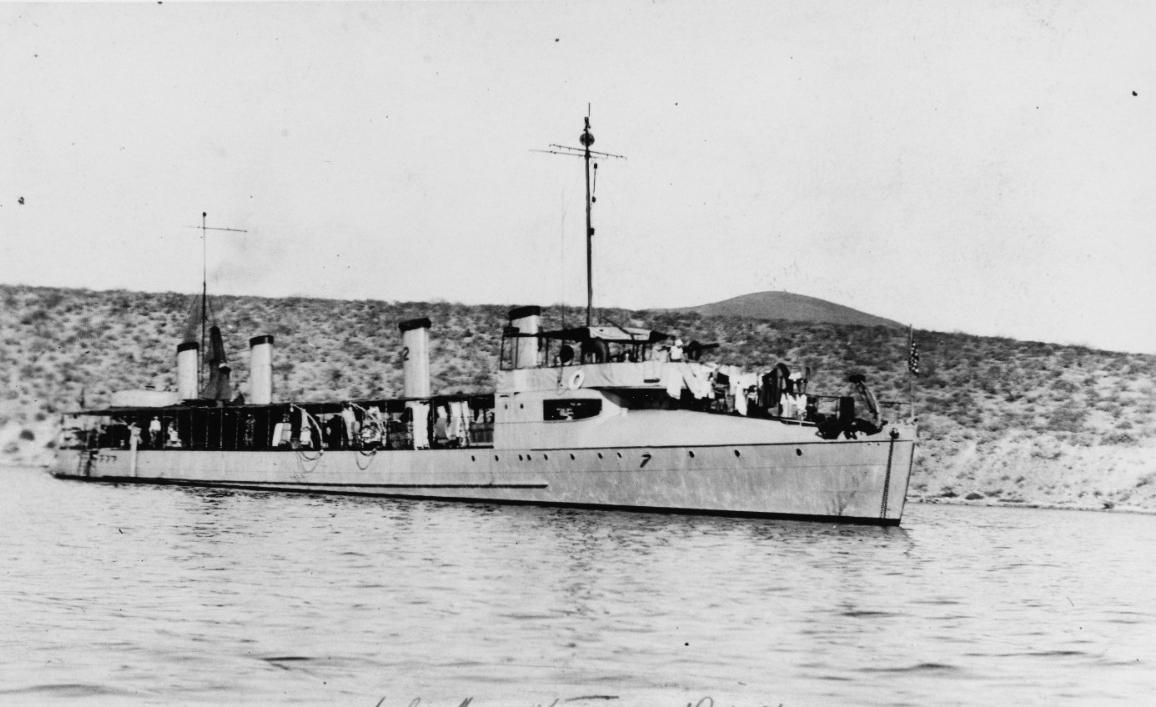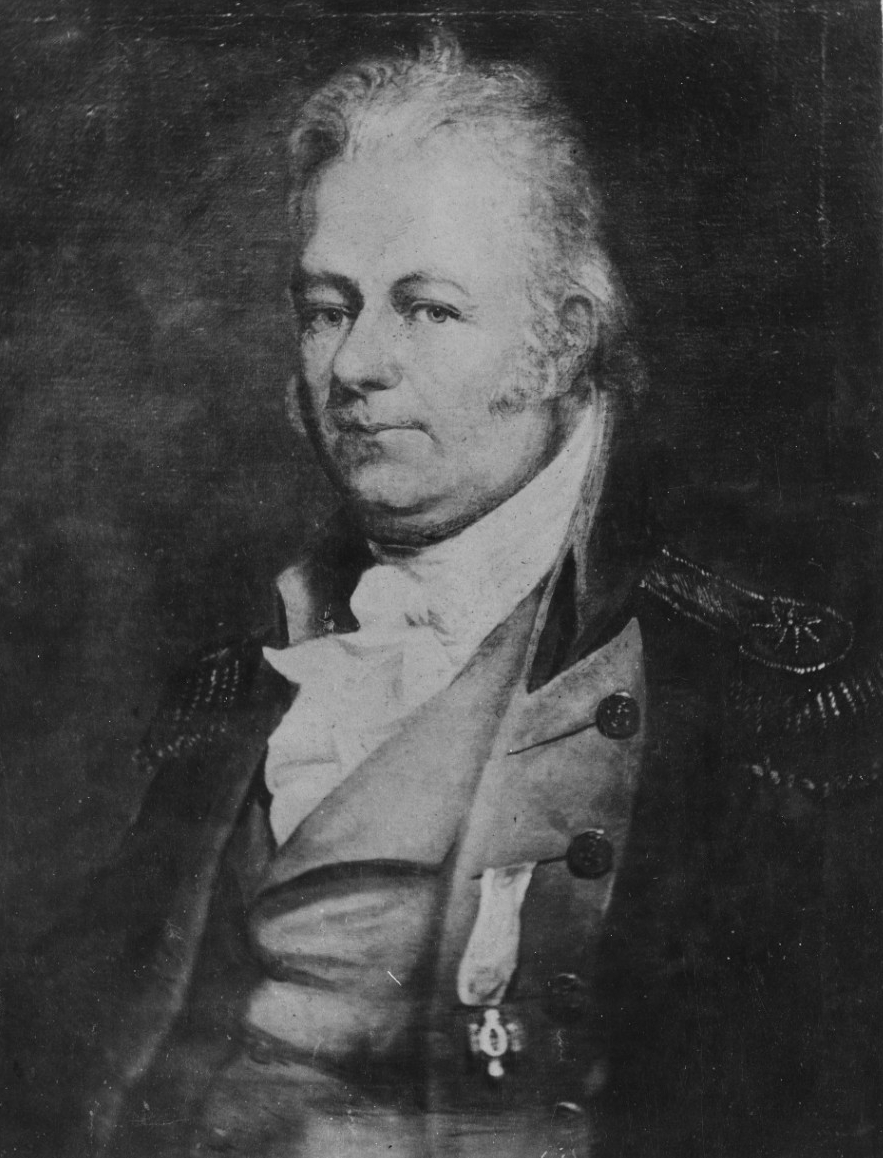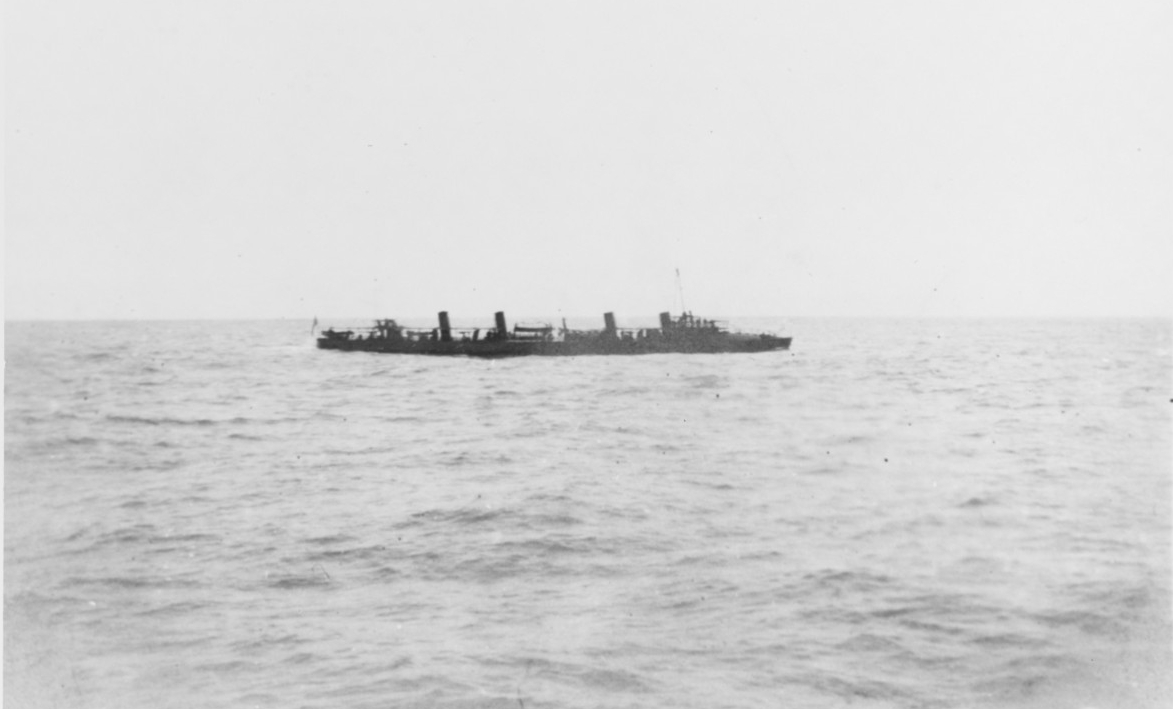Truxtun II (Torpedo Boat Destroyer No. 14)
(Torpedo Boat Destroyer No. 14; displacement 605 tons (full load) ; length 248'0" (waterline); beam 23'l¼"; draft 10'11" (maximum); speed 30 knots (trial); complement 72; armament 2 3-inch rifled cannon, 6 6-pounder rifled cannon, 2 18-inch torpedo tubes; class Truxtun)
Thomas Truxtun was born on 17 February 1755 near Hempstead, Long Island, New York. When his father died in 1765, young Truxtun came under the guardianship of John Troup of Jamaica, Long Island. Two years later, at the age of 12, he embarked upon a seafaring career, sailing with Captains Joseph Holmes and James Chambers in the London trade. At 16, he was pressed into service in the Royal Navy on board HMS Prudent. Truxtun's British commanding officer observed the lad's natural abilities and offered him aid in securing a midshipman's warrant. However, Truxtum declined, obtained his release through the good offices of influential friends, and returned to mercantile service. By the age of 20, he had risen to command of Andrew Caldwell in which he brought large quantities of gunpowder into Philadelphia in 1775. Later that year, his ship was seized by HMS Argo off St. Kitts in the West Indies, an act that caused some natural resentment in the young sea captain.
By the time Truxtun made his way back to Philadelphia, the colonies had reached the point of open rupture with the mother country. He signed on as a lieutenant in Congress, the first privateer to be fitted out for service against Great Britain. During the remainder of 1776, Truxtun participated in the capture of several prizes off the coast of Cuba. In 1777, he fitted out Continental Navy sloop Independence and sailed her to the Azores where he took three prizes. Upon his return, Truxtun fitted out Mars and made a highly successful cruise in the English Channel. Successively, he commanded Independence once more and then, in turn, Commerce and St. James.
In addition to privateering, Truxtun's ships also carried cargoes of military stores to the colonies. On one voyage in St. James, he landed a valuable cargo of gunpowder and military stores at Philadelphia. At a dinner to celebrate the feat, George Washington declared that Truxton's services had been worth those of a regiment. On another occasion, St. James, still under his command, carried Thomas Barclay, the American consul, to France.
Following the Revolution, Truxtun resumed his career in mercantile service and commanded Canton, the first Philadelphia ship to enter the China trade. When the United States Navy was organized, he was selected as one of its first six captains on 4 June 1798. He was assigned command of one of the new frigates then under construction. His ship, Constellation, was completed late in June; and he put to sea immediately to prosecute the undeclared naval war with revolutionary France.
The frigate, accompanied by a squadron of smaller ships, operated in the West Indies between St. Christopher and Puerto Rico. On 9 February 1799, Truxtun scored the first of his two most famous victories. After an hour's fight, Constellation battered Insurgente into submission, killing 29 and wounding 44 of the French frigate's crew. Truxtun brought Insurgente into St. Christopher where she was refitted and commissioned in the United States Navy.
Almost a year later, on 1 February 1800, he sighted the 50-gun French frigate La Vengeance, chased her all day, and finally overhauled her that evening. For the next five hours, Truxtun used superior American gunnery and the prevailing heavy seas to his advantage and, by 0100, completely overcame La Vengeance's initial broadside superiority. During the action, the French warship had struck her colors several times, but darkness had prevented Truxtun from seeing the signal. Accordingly, the engagement continued until every gun on board the Frenchman went silent. The French frigate then sheered off to flee, and Constellation's battle-damaged rigging made it impossible for the American frigate to pursue her escaping victim. After refitting Constellation at Jamaica, Truxtun returned with her to Norfolk late in March.
After commanding frigate President in the West Indies from mid-1800 to May 1801, Truxtun was appointed to command the squadron then fitting out for the Tripolitan expedition. Through a misunderstanding engendered by his request to have a captain appointed to command his flagship Chesapeake, Truxtun's unintended resignation from the Navy was accepted in Washington.
Commodore Truxtun retired first to Perth Amboy, N.J., and thence to Philadelphia, where he was active in local politics for the rest of his life. In 1809, he led the agitation in Philadelphia against the Embargo. The following year, he was unsuccessful in his bid for a seat in Congress under the Federalist banner. From 1816 to 1819, Truxtun served as the sheriff of Philadelphia. Commodore Truxtun died at Philadelphia on 5 May 1822 and was interred there at Christ Church.
II
The second Truxtun (Torpedo Boat Destroyer No. 14) was laid down on 13 November 1899 at Sparrows Point, Md., by the Maryland Steel Co.; launched on 15 August 1901; sponsored by Miss Isabelle Truxtun; and commissioned on 11 September 1902, Lt. Archibald H. Davis in command.
Upon commissioning, Truxtun was assigned to the 2d Torpedo Flotilla, and her commanding officer was appointed commander of the flotilla. She conducted trials out of Norfolk until 14 January 1903 and received her final acceptance on 24 April. Torpedo boat destroyers were a relatively new type of warship and Truxton prepared for her mission of escorting warships and attacking fast torpedo boats through the summer. In August, she participated in maneuvers off Frenchman's Bay, Maine, in the Presidential review by Theodore Roosevelt at Oyster Bay, and in a joint Army-Navy exercise off Portland, Maine.
On 26 September, the 2d Torpedo Flotilla became a unit of the Coast Squadron, North Atlantic Fleet. Truxtun joined that squadron in target practice off the Massachusetts coast before returning to Norfolk later that fall for repairs.
For the next four years, Truxtun operated along the Atlantic coast and in the West Indies. In December 1907, she and five other destroyers assembled in Hampton Roads with the battleships of the Atlantic Fleet. President Theodore Roosevelt reviewed the fleet once more and then, this "Great White Fleet" passed between Capes Charles and Henry to embark upon its famous round-the-world voyage. Truxtun escorted the fleet on the first leg of its voyage, going as far as the west coast. Along the way, she visited ports in Brazil, Chile, Peru, Panama, and Mexico. The fleet reached San Francisco in May 1908, and the destroyers were detached and reassigned to the Pacific Torpedo Fleet. After repairs at Mare Island Navy Yard that summer, Truxtun joined her sister destroyers in a training voyage to Hawaii and Samoa. She returned to the west coast at San Diego, her new base of operations, early in December. She began her duty along the Pacific coast of North America with a voyage to Alaskan waters, visiting Seattle, Sitka, Seward and Juneau.
Truxtun made several cruises with the Pacific Torpedo Fleet out of San Diego over the next four years, though Navy-wide manpower shortages and financial stringency saw her transferred to the Pacific Reserve Fleet on 1 June 1912. Though technically in reserve, she remained somewhat active, periodically putting to sea to check her machinery and to maintain herself ". . . in constant readiness for sea."
Her reserve status was short-lived in any case, as Truxton was placed back in full commission on 12 October 1912 and resumed normal activity along the coast. On two occasions, in the summer of 1914 and again in the summer of 1916, the torpedo boat destroyer steamed to Mexican waters to protect American interests during the series of political convulsions that plagued that nation. By July 1916, she had returned to semi-inactivity as a unit of the reserve division of the Coast Torpedo Force later re-designated Division 2 (Reserve), Coast Torpedo Force. As before, however, she conducted sporadic cruises along the California coast to maintain herself in a state of readiness.
On 18 February 1917, Truxtun was returned to full commission for the third and final time, Lt. James G. Ware in command. Initially, she was assigned to patrol duty in the area of the Panama Canal. On 6 April 1917, the day the United States entered World War I, she departed Colon harbor and headed south to Puerto Colombia, Colombia, where she watched the German ship SS Prinz August Wilhelm which was anchored in the harbor. She was relieved by Stewart (Destroyer No. 13) on 14 April and returned to Colon the following day. For almost three months, she patrolled the Pacific coastal waters of Panama and Colombia, periodically doubling as a submarine tender. On Independence Day 1917, she transited the Panama Canal and, the following day, departed Balboa in company with Stewart, Preble (Destroyer No. 12), and Whipple (Destroyer No. 15). The four destroyers reached Hampton Roads on 13 July. Through the end of August, Truxtun patrolled Chesapeake Bay and conducted maneuvers off the coast. She made port calls at New York and Philadelphia, on one occasion acting as escort for Texas (BB-35).
On 31 August, Truxtun departed Philadelphia for duty in the Azores. After a short stop-over in Bermuda, she arrived at Ponta Delgada on 16 September. The destroyer operated from Ponta Delgada until early December. She and Whipple met SS Caproni on 30 September and escorted her into Ponta Delgada on 3 October. In mid-October, she made a short voyage to Funchal, Madeira Island, and back. Later that month, she participated in a search for the survivors of a torpedoed ship. Truxtun cleared Ponta Delgada on 6 December and headed, via Gibraltar, for France. She reached Brest on 15 December. Operating from that port, the destroyer convoyed merchant ships and conducted patrols against German U-boats for the remainder of World War I.
During the ensuing 12 months, she experienced two adventures. The first came on the night of 17 April 1918 when the munitions-laden steamship SS Florence H. exploded into flame in Quiberon Bay. For steering his destroyer into the flaming seas surrounding the stricken cargo ship and helping to rescue many of her crewmen, Truxtun's commanding officer, Lt. Ware, was, awarded the Distinguished Service Medal. Her second scrape involved the enemy. At about 0900 on 18 May, while escorting a convoy, she sighted an underwater disturbance and immediately charged to the attack. The warship dropped several patterns of depth charges and fired several rounds from her guns. However, many of the depth charges failed to function properly. The U-boat, believed to have been UC-56, made good her escape; and Truxtun returned to the convoy at about 0930.
Just over a month after the armistice ended World War I, Truxtun bade farewell to Europe. Departing Brest on 18 December in company with Flusser (Destroyer No. 20), Stewart, Whipple, and Warden (Destroyer No. 16), she steamed, via Ponta Delgada and Bermuda, back to the United States. She entered the Delaware River on 3 January 1919 and was decommisioned at Philadelphia on 18 July. Her name was struck from the Navy list on 15 September 1919. She was sold to Joseph G. Hitner, of Philadelphia, on 3 January 1920 for conversion to mercantile service as a motor fruit carrier.
Minor corrections, 7 August 2007





